2006 FORD F SERIES MOTORHOME AND COMMERCIAL CHASSIS warning light
[x] Cancel search: warning lightPage 54 of 128
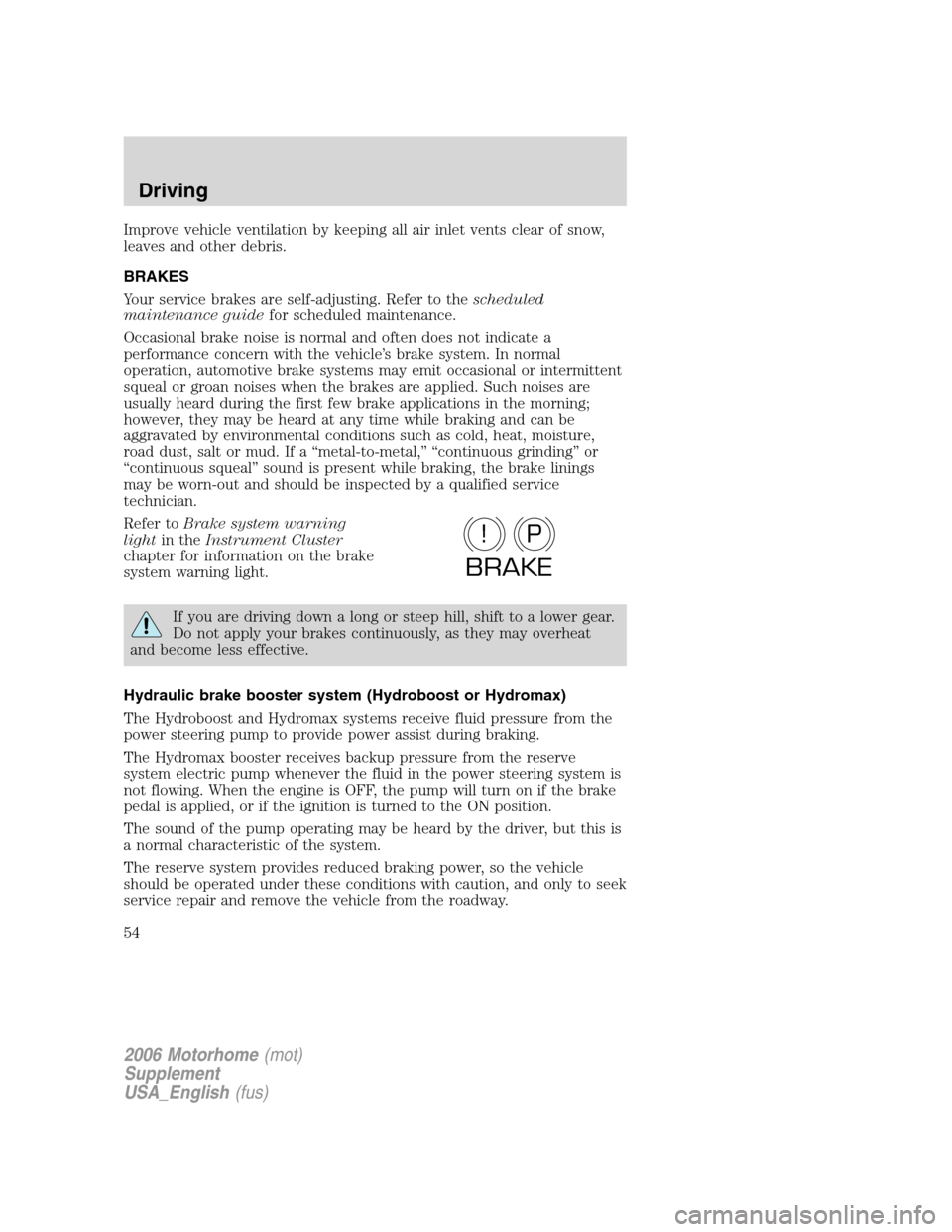
Improve vehicle ventilation by keeping all air inlet vents clear of snow,
leaves and other debris.
BRAKES
Your service brakes are self-adjusting. Refer to thescheduled
maintenance guidefor scheduled maintenance.
Occasional brake noise is normal and often does not indicate a
performance concern with the vehicle’s brake system. In normal
operation, automotive brake systems may emit occasional or intermittent
squeal or groan noises when the brakes are applied. Such noises are
usually heard during the first few brake applications in the morning;
however, they may be heard at any time while braking and can be
aggravated by environmental conditions such as cold, heat, moisture,
road dust, salt or mud. If a “metal-to-metal,” “continuous grinding” or
“continuous squeal” sound is present while braking, the brake linings
may be worn-out and should be inspected by a qualified service
technician.
Refer toBrake system warning
lightin theInstrument Cluster
chapter for information on the brake
system warning light.
If you are driving down a long or steep hill, shift to a lower gear.
Do not apply your brakes continuously, as they may overheat
and become less effective.
Hydraulic brake booster system (Hydroboost or Hydromax)
The Hydroboost and Hydromax systems receive fluid pressure from the
power steering pump to provide power assist during braking.
The Hydromax booster receives backup pressure from the reserve
system electric pump whenever the fluid in the power steering system is
not flowing. When the engine is OFF, the pump will turn on if the brake
pedal is applied, or if the ignition is turned to the ON position.
The sound of the pump operating may be heard by the driver, but this is
a normal characteristic of the system.
The reserve system provides reduced braking power, so the vehicle
should be operated under these conditions with caution, and only to seek
service repair and remove the vehicle from the roadway.
P!
BRAKE
2006 Motorhome(mot)
Supplement
USA_English(fus)
Driving
54
Page 55 of 128
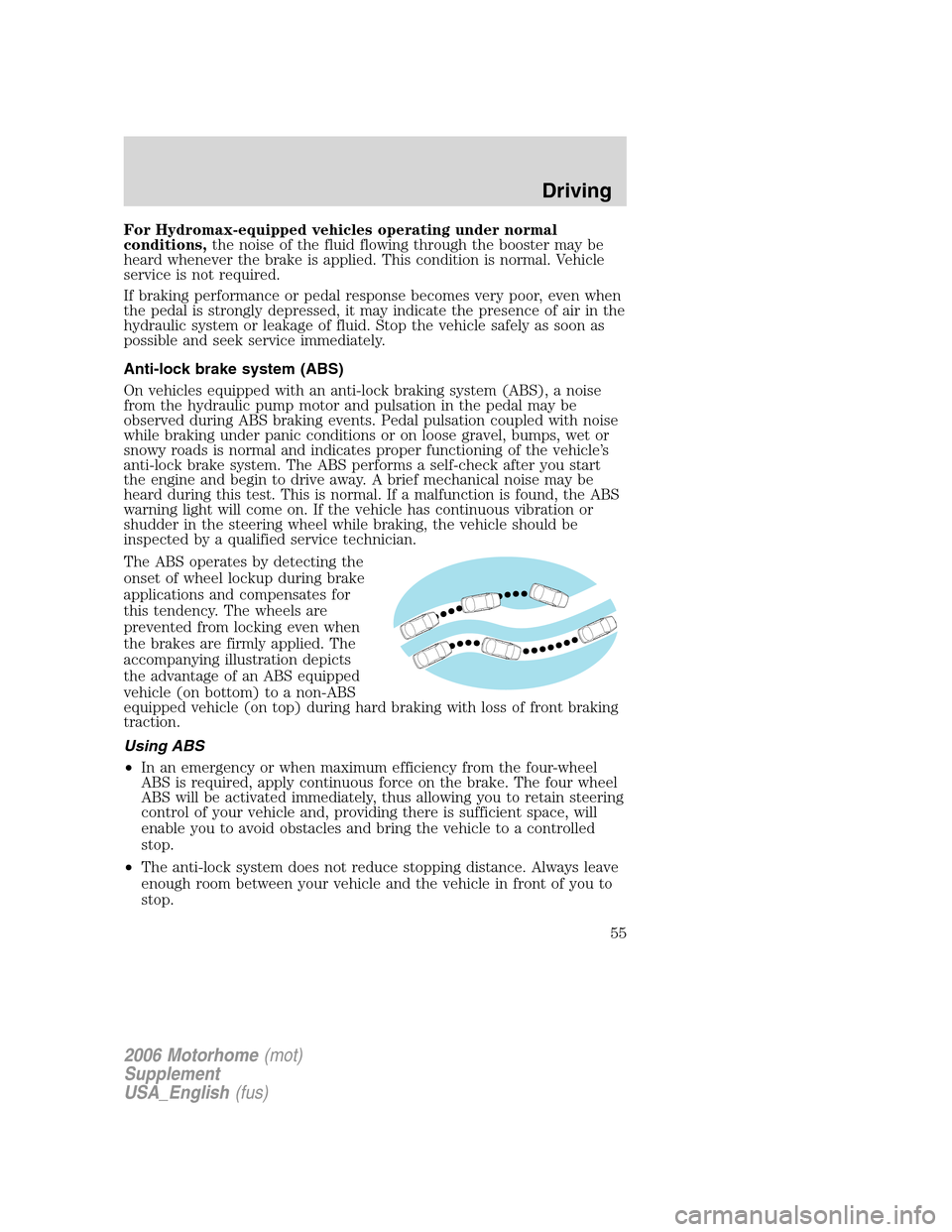
For Hydromax-equipped vehicles operating under normal
conditions,the noise of the fluid flowing through the booster may be
heard whenever the brake is applied. This condition is normal. Vehicle
service is not required.
If braking performance or pedal response becomes very poor, even when
the pedal is strongly depressed, it may indicate the presence of air in the
hydraulic system or leakage of fluid. Stop the vehicle safely as soon as
possible and seek service immediately.
Anti-lock brake system (ABS)
On vehicles equipped with an anti-lock braking system (ABS), a noise
from the hydraulic pump motor and pulsation in the pedal may be
observed during ABS braking events. Pedal pulsation coupled with noise
while braking under panic conditions or on loose gravel, bumps, wet or
snowy roads is normal and indicates proper functioning of the vehicle’s
anti-lock brake system. The ABS performs a self-check after you start
the engine and begin to drive away. A brief mechanical noise may be
heard during this test. This is normal. If a malfunction is found, the ABS
warning light will come on. If the vehicle has continuous vibration or
shudder in the steering wheel while braking, the vehicle should be
inspected by a qualified service technician.
The ABS operates by detecting the
onset of wheel lockup during brake
applications and compensates for
this tendency. The wheels are
prevented from locking even when
the brakes are firmly applied. The
accompanying illustration depicts
the advantage of an ABS equipped
vehicle (on bottom) to a non-ABS
equipped vehicle (on top) during hard braking with loss of front braking
traction.
Using ABS
•In an emergency or when maximum efficiency from the four-wheel
ABS is required, apply continuous force on the brake. The four wheel
ABS will be activated immediately, thus allowing you to retain steering
control of your vehicle and, providing there is sufficient space, will
enable you to avoid obstacles and bring the vehicle to a controlled
stop.
•The anti-lock system does not reduce stopping distance. Always leave
enough room between your vehicle and the vehicle in front of you to
stop.
2006 Motorhome(mot)
Supplement
USA_English(fus)
Driving
55
Page 56 of 128
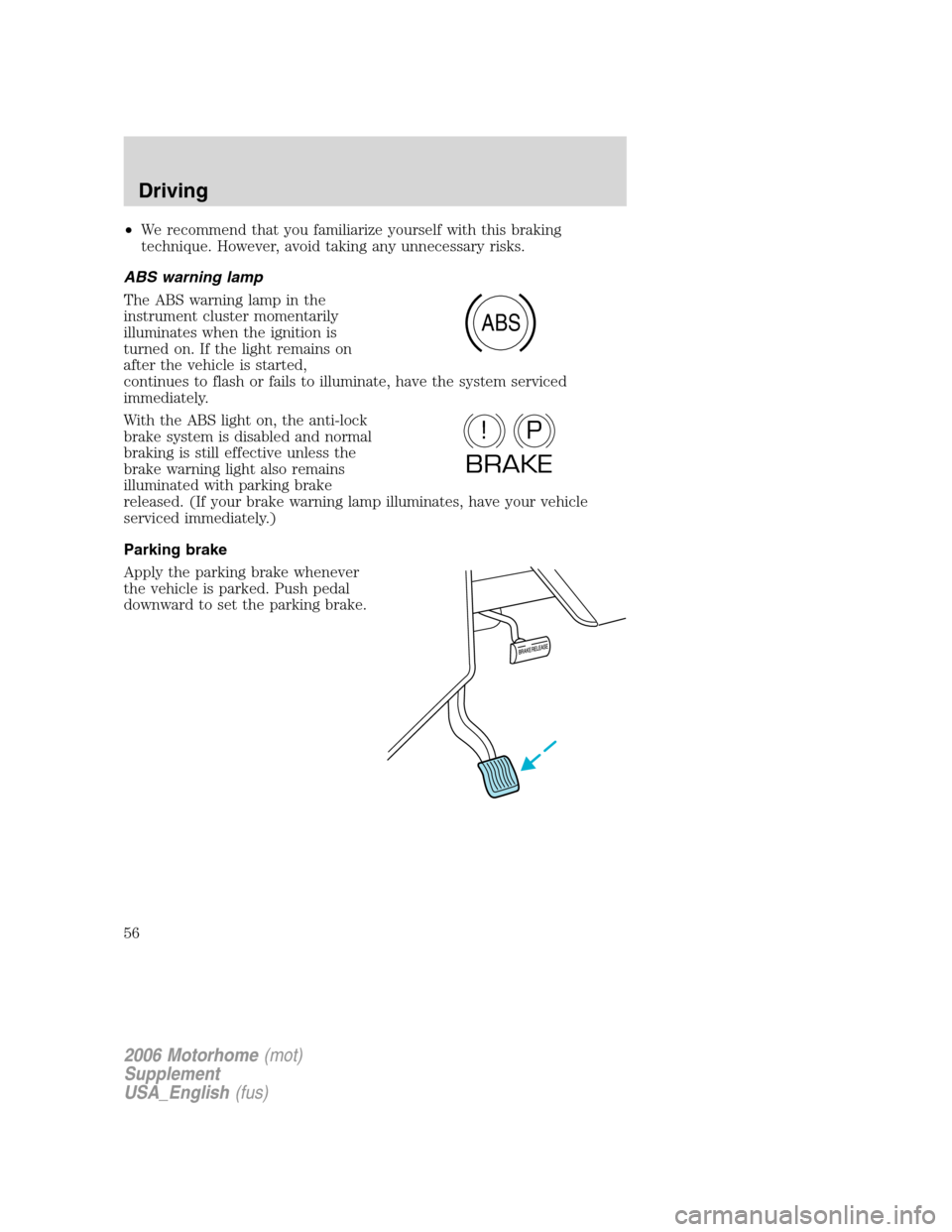
•We recommend that you familiarize yourself with this braking
technique. However, avoid taking any unnecessary risks.
ABS warning lamp
The ABS warning lamp in the
instrument cluster momentarily
illuminates when the ignition is
turned on. If the light remains on
after the vehicle is started,
continues to flash or fails to illuminate, have the system serviced
immediately.
With the ABS light on, the anti-lock
brake system is disabled and normal
braking is still effective unless the
brake warning light also remains
illuminated with parking brake
released. (If your brake warning lamp illuminates, have your vehicle
serviced immediately.)
Parking brake
Apply the parking brake whenever
the vehicle is parked. Push pedal
downward to set the parking brake.
ABS
P!
BRAKE
2006 Motorhome(mot)
Supplement
USA_English(fus)
Driving
56
Page 59 of 128
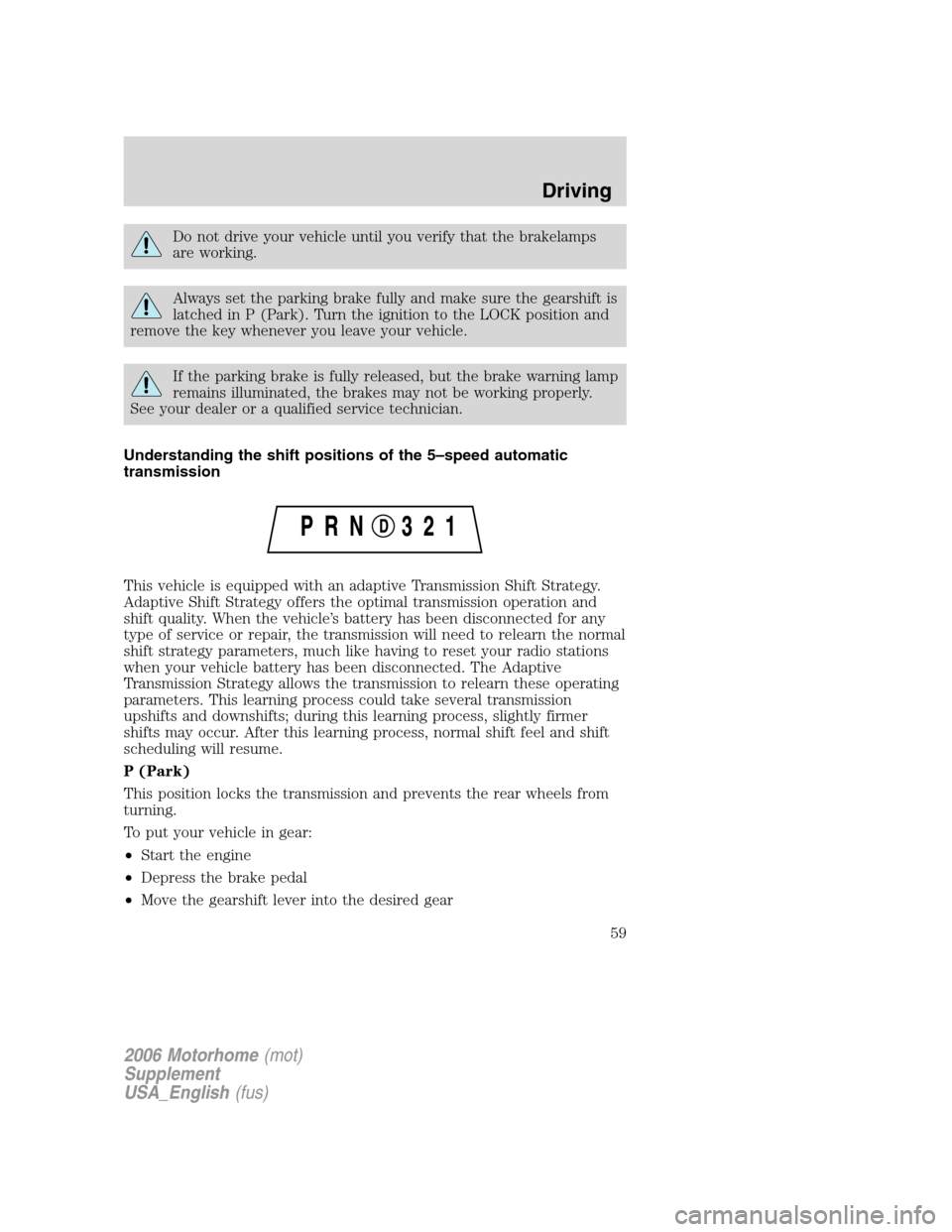
Do not drive your vehicle until you verify that the brakelamps
are working.
Always set the parking brake fully and make sure the gearshift is
latched in P (Park). Turn the ignition to the LOCK position and
remove the key whenever you leave your vehicle.
If the parking brake is fully released, but the brake warning lamp
remains illuminated, the brakes may not be working properly.
See your dealer or a qualified service technician.
Understanding the shift positions of the 5–speed automatic
transmission
This vehicle is equipped with an adaptive Transmission Shift Strategy.
Adaptive Shift Strategy offers the optimal transmission operation and
shift quality. When the vehicle’s battery has been disconnected for any
type of service or repair, the transmission will need to relearn the normal
shift strategy parameters, much like having to reset your radio stations
when your vehicle battery has been disconnected. The Adaptive
Transmission Strategy allows the transmission to relearn these operating
parameters. This learning process could take several transmission
upshifts and downshifts; during this learning process, slightly firmer
shifts may occur. After this learning process, normal shift feel and shift
scheduling will resume.
P (Park)
This position locks the transmission and prevents the rear wheels from
turning.
To put your vehicle in gear:
•Start the engine
•Depress the brake pedal
•Move the gearshift lever into the desired gear
2006 Motorhome(mot)
Supplement
USA_English(fus)
Driving
59
Page 108 of 128
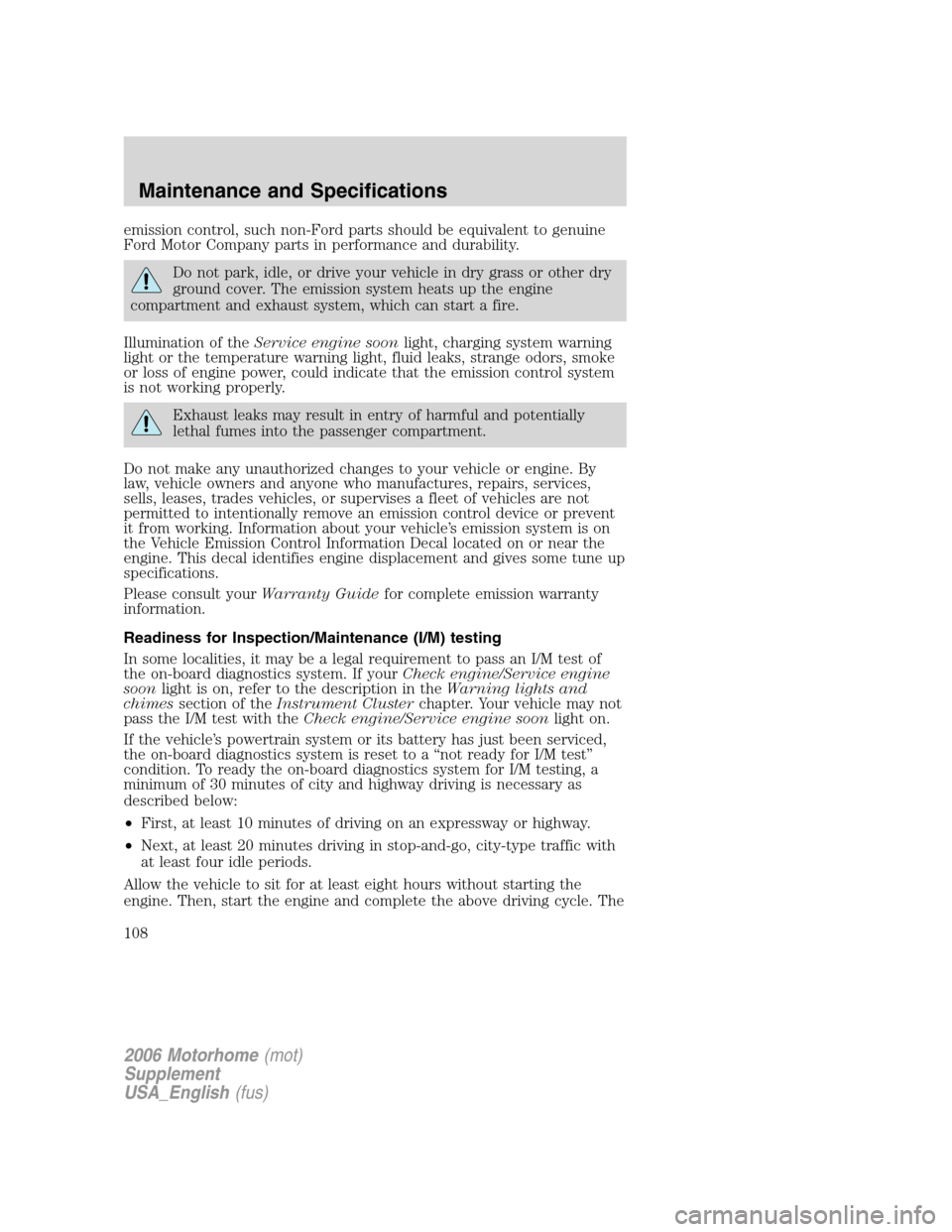
emission control, such non-Ford parts should be equivalent to genuine
Ford Motor Company parts in performance and durability.
Do not park, idle, or drive your vehicle in dry grass or other dry
ground cover. The emission system heats up the engine
compartment and exhaust system, which can start a fire.
Illumination of theService engine soonlight, charging system warning
light or the temperature warning light, fluid leaks, strange odors, smoke
or loss of engine power, could indicate that the emission control system
is not working properly.
Exhaust leaks may result in entry of harmful and potentially
lethal fumes into the passenger compartment.
Do not make any unauthorized changes to your vehicle or engine. By
law, vehicle owners and anyone who manufactures, repairs, services,
sells, leases, trades vehicles, or supervises a fleet of vehicles are not
permitted to intentionally remove an emission control device or prevent
it from working. Information about your vehicle’s emission system is on
the Vehicle Emission Control Information Decal located on or near the
engine. This decal identifies engine displacement and gives some tune up
specifications.
Please consult yourWarranty Guidefor complete emission warranty
information.
Readiness for Inspection/Maintenance (I/M) testing
In some localities, it may be a legal requirement to pass an I/M test of
the on-board diagnostics system. If yourCheck engine/Service engine
soonlight is on, refer to the description in theWarning lights and
chimessection of theInstrument Clusterchapter. Your vehicle may not
pass the I/M test with theCheck engine/Service engine soonlight on.
If the vehicle’s powertrain system or its battery has just been serviced,
the on-board diagnostics system is reset to a “not ready for I/M test”
condition. To ready the on-board diagnostics system for I/M testing, a
minimum of 30 minutes of city and highway driving is necessary as
described below:
•First, at least 10 minutes of driving on an expressway or highway.
•Next, at least 20 minutes driving in stop-and-go, city-type traffic with
at least four idle periods.
Allow the vehicle to sit for at least eight hours without starting the
engine. Then, start the engine and complete the above driving cycle. The
2006 Motorhome(mot)
Supplement
USA_English(fus)
Maintenance and Specifications
108
Page 123 of 128
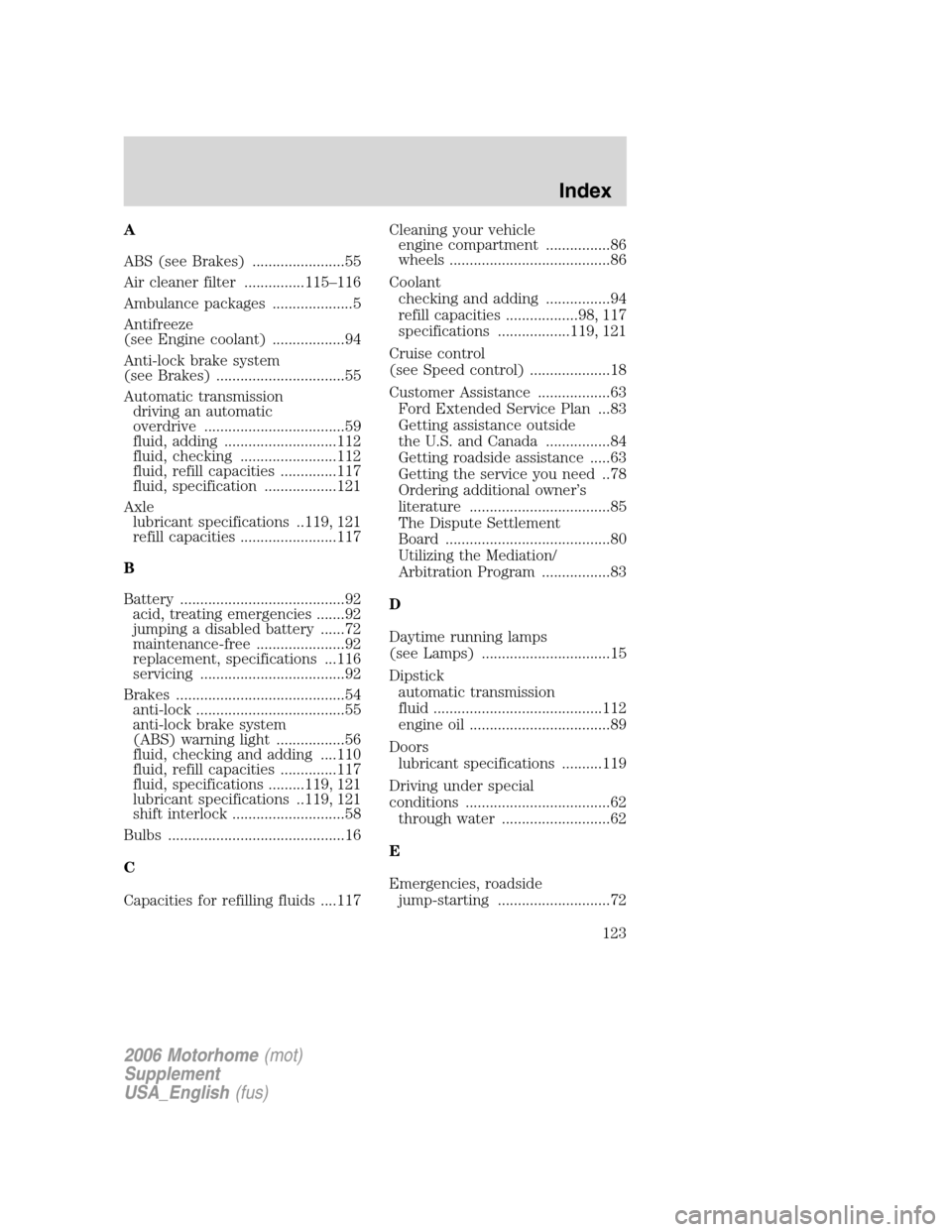
A
ABS (see Brakes) .......................55
Air cleaner filter ...............115–116
Ambulance packages ....................5
Antifreeze
(see Engine coolant) ..................94
Anti-lock brake system
(see Brakes) ................................55
Automatic transmission
driving an automatic
overdrive ...................................59
fluid, adding ............................112
fluid, checking ........................112
fluid, refill capacities ..............117
fluid, specification ..................121
Axle
lubricant specifications ..119, 121
refill capacities ........................117
B
Battery .........................................92
acid, treating emergencies .......92
jumping a disabled battery ......72
maintenance-free ......................92
replacement, specifications ...116
servicing ....................................92
Brakes ..........................................54
anti-lock .....................................55
anti-lock brake system
(ABS) warning light .................56
fluid, checking and adding ....110
fluid, refill capacities ..............117
fluid, specifications .........119, 121
lubricant specifications ..119, 121
shift interlock ............................58
Bulbs ............................................16
C
Capacities for refilling fluids ....117Cleaning your vehicle
engine compartment ................86
wheels ........................................86
Coolant
checking and adding ................94
refill capacities ..................98, 117
specifications ..................119, 121
Cruise control
(see Speed control) ....................18
Customer Assistance ..................63
Ford Extended Service Plan ...83
Getting assistance outside
the U.S. and Canada ................84
Getting roadside assistance .....63
Getting the service you need ..78
Ordering additional owner’s
literature ...................................85
The Dispute Settlement
Board .........................................80
Utilizing the Mediation/
Arbitration Program .................83
D
Daytime running lamps
(see Lamps) ................................15
Dipstick
automatic transmission
fluid ..........................................112
engine oil ...................................89
Doors
lubricant specifications ..........119
Driving under special
conditions ....................................62
through water ...........................62
E
Emergencies, roadside
jump-starting ............................72
2006 Motorhome(mot)
Supplement
USA_English(fus)
Index
123
Page 125 of 128
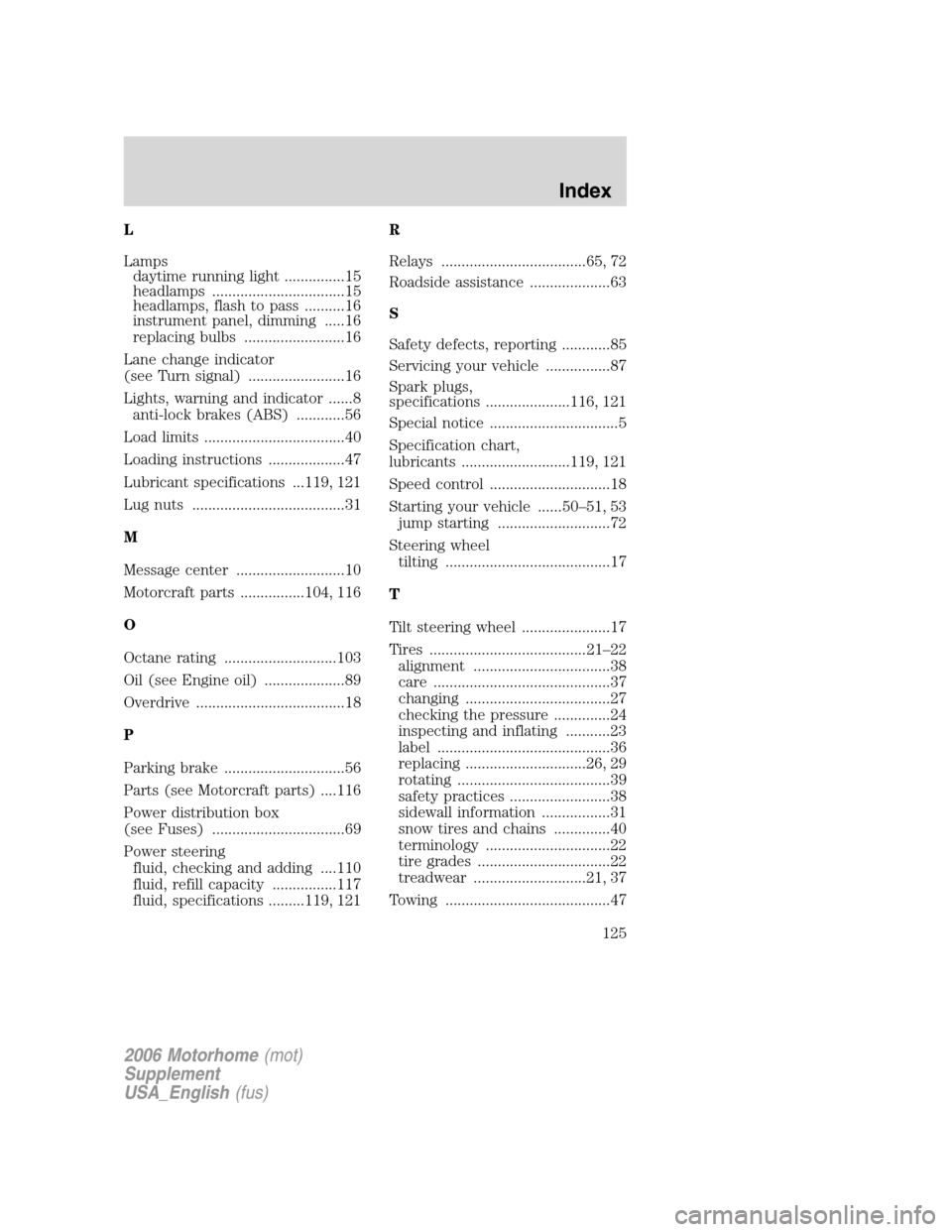
L
Lamps
daytime running light ...............15
headlamps .................................15
headlamps, flash to pass ..........16
instrument panel, dimming .....16
replacing bulbs .........................16
Lane change indicator
(see Turn signal) ........................16
Lights, warning and indicator ......8
anti-lock brakes (ABS) ............56
Load limits ...................................40
Loading instructions ...................47
Lubricant specifications ...119, 121
Lug nuts ......................................31
M
Message center ...........................10
Motorcraft parts ................104, 116
O
Octane rating ............................103
Oil (see Engine oil) ....................89
Overdrive .....................................18
P
Parking brake ..............................56
Parts (see Motorcraft parts) ....116
Power distribution box
(see Fuses) .................................69
Power steering
fluid, checking and adding ....110
fluid, refill capacity ................117
fluid, specifications .........119, 121R
Relays ....................................65, 72
Roadside assistance ....................63
S
Safety defects, reporting ............85
Servicing your vehicle ................87
Spark plugs,
specifications .....................116, 121
Special notice ................................5
Specification chart,
lubricants ...........................119, 121
Speed control ..............................18
Starting your vehicle ......50–51, 53
jump starting ............................72
Steering wheel
tilting .........................................17
T
Tilt steering wheel ......................17
Tires .......................................21–22
alignment ..................................38
care ............................................37
changing ....................................27
checking the pressure ..............24
inspecting and inflating ...........23
label ...........................................36
replacing ..............................26, 29
rotating ......................................39
safety practices .........................38
sidewall information .................31
snow tires and chains ..............40
terminology ...............................22
tire grades .................................22
treadwear ............................21, 37
Towing .........................................47
2006 Motorhome(mot)
Supplement
USA_English(fus)
Index
125
Page 126 of 128
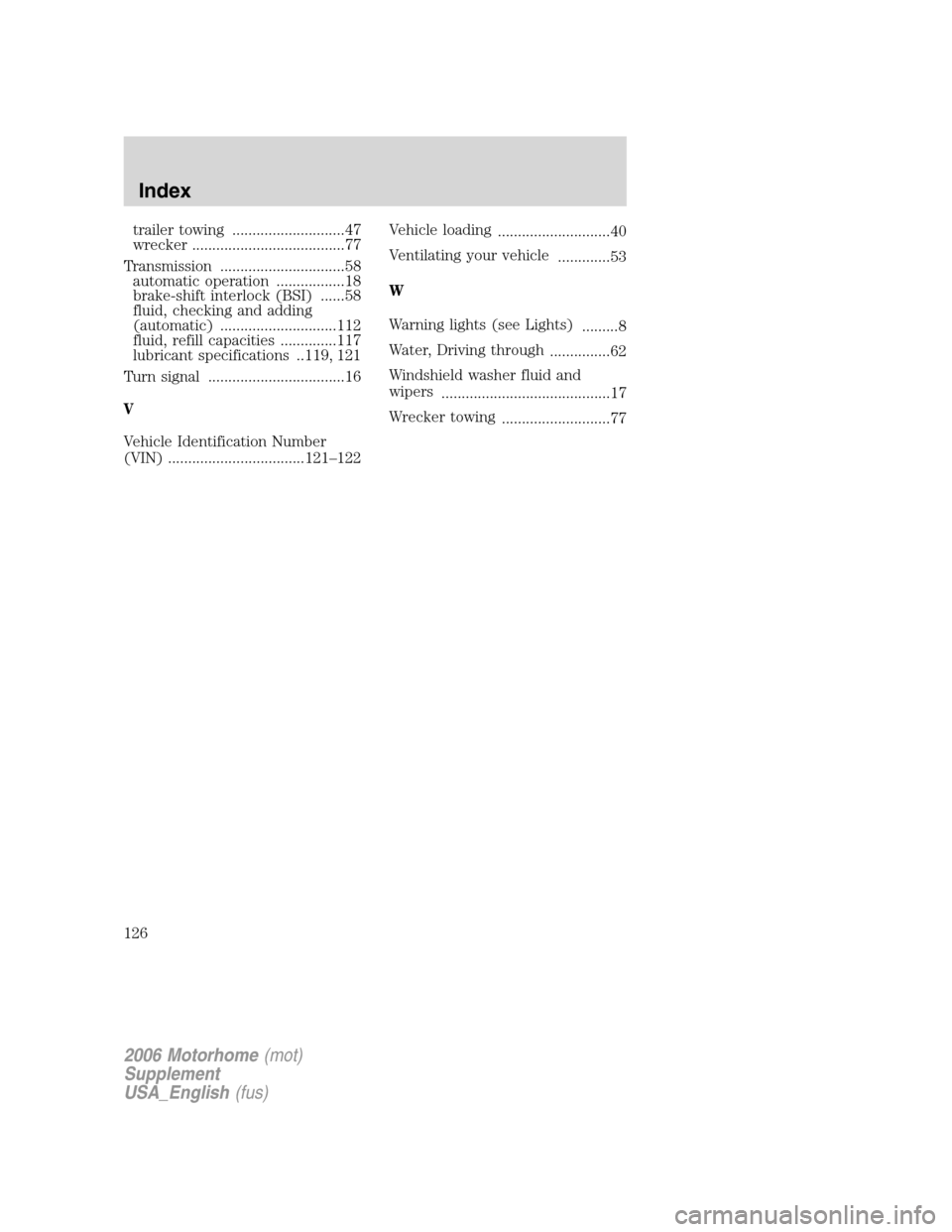
trailer towing ............................47
wrecker ......................................77
Transmission ...............................58
automatic operation .................18
brake-shift interlock (BSI) ......58
fluid, checking and adding
(automatic) .............................112
fluid, refill capacities ..............117
lubricant specifications ..119, 121
Turn signal ..................................16
V
Vehicle Identification Number
(VIN) ..................................121–122Vehicle loading
............................40
Ventilating your vehicle
.............53
W
Warning lights (see Lights)
.........8
Water, Driving through
...............62
Windshield washer fluid and
wipers
..........................................17
Wrecker towing
...........................77
2006 Motorhome(mot)
Supplement
USA_English(fus)
Index
126